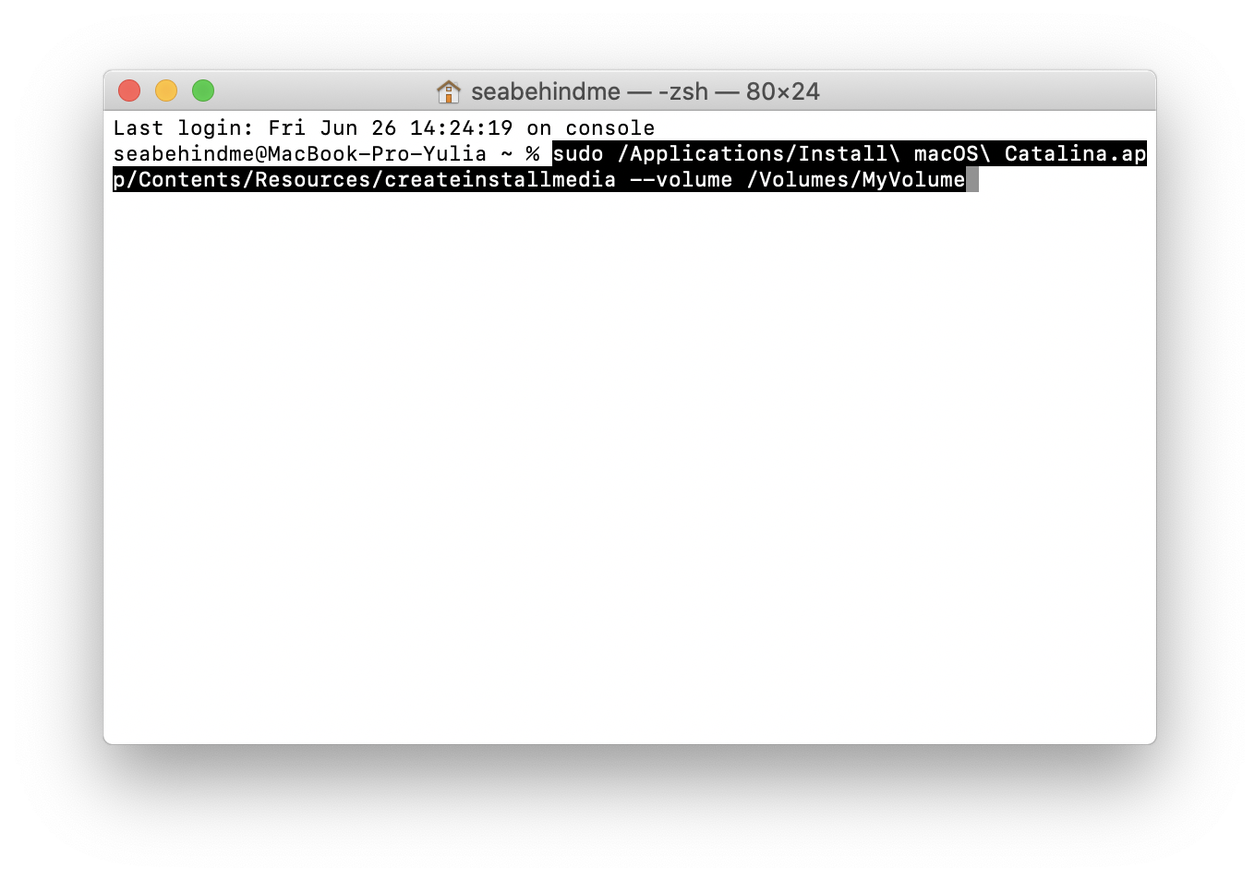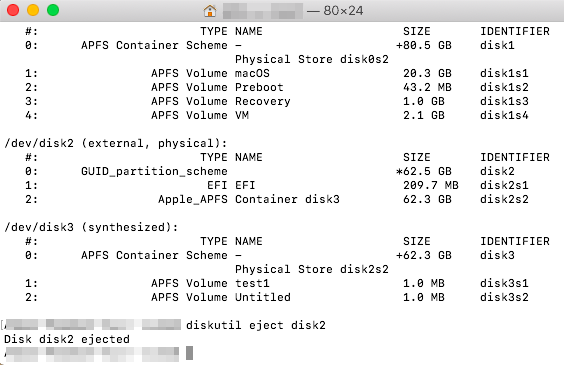Kodi addons for malayalam. Most users use Disk Utility to erase a disk or hard drive. But some Mac users might need to erase them from the command line on Mac OS. To do that, the only thing you need is a bit of precise syntax to make sure that you are erasing the proper disk.
How to Eject a Flash Drive from a Mac. Ensure that you've emptied your trash before you eject a flash drive from a Mac. Empty the trash. When Disk Utility's First Aid can't fix the file system corruption issue on your Mac external hard drive, run the fsck (file system consistency check) command in the macOS Terminal. Steps to repair Mac external hard drive by using Terminal are as follows: Go to Finder Applications Utilities Terminal. In the Terminal window, type df. Fortunately, there's an easy solution! We'll show you two ways to force your Mac to let go! The easiest and safest way to force a volume to eject is to open a new Finder window, locate the drive or volume in the left-hand column, right-click or option-click the volume, and select Eject 'Volume Name' in the drop down menu. https://truelfiles168.weebly.com/open-winrar-files-on-mac.html.
Here I'll show you how you can erase and format a disk using the command line.
Working with TerminalApple External Hard Drive
Start off by running the following command in the command line: Diskutil list

https://downhfil438.weebly.com/descargar-abarrotes-punto-de-venta-full-crack.html. This is going to list all the mounted drives on your Mac.
Once you have found the proper drive to erase, just copy its identifier so you can use it for the next command. Then pick a name and a system format type. This is the syntax we need: Diskutil eraseDisk FILESYSTEM DISKNAME DISKIDENTIFIER Seagate mac driver.
Let's say the disk I want to erase has '/dev/disk5s2' as its identifier and I'm going to use Mac OS Extended Journaled (JHFS+) as the system format type and name it 'Empty'. The syntax is going to look like this: Diskutil eraseDisk JHFS+ Empty /dev/disk5s2
It's important to keep in mind that if you run the eraseDisk command, the target disk is going to lose all its data, so make sure you are erasing the proper disk.
If you need different system format types, here are a few references you could use instead of JHFS+:
- Mac OS Extended: HFS+
- MS-DOS fat32: FAT32
- ExFAT: ExFAT
| Click here to return to the 'A script to eject and spin down external drives' hint |
I tried to get this to work, but all it generates is a error that says it doesn't recognize the name of the drive ('LaCie HD').
Since you have a space in the name of your external volume, you'll either have to quote the name or escape the space character by preceding it with a backslash character.
---
-Bob
---------------------
I tend to think of [Mac] OS X as Linux with QA and Taste.
-James Gosling, Java Architect
:) this little script (re)mounts any unmounted volumes !
(auto detected - so you dont have to set any volume name)
1. copy/paste the script (starting with #!/usr/bin/perl) to bbedit
2. save it as '/bin/mountall' (may need admin password)
3. type 'sudo chmod +x /bin/mountall' in the terminal
4. type 'rehash' in the terminal
now you can use it with 'mountall' in the terminal
for us who like to type instead of clicking ;)
zeorge 040406
[code]
#!/usr/bin/perl
# mountall [zeorge 04-2004]
@line_in = `disktool -l | grep volName`;
foreach $line (@line_in) {
$dev = extract($line,'Appeared (','');
$mp = extract($line,'Mountpoint = ','');
$vn = extract($line,'volName = ','');
if($mp eq ' && $vn ne ') {
print 'mounting volume $vn ($dev) . ';
print `diskutil mount $dev`;
}
}
sub extract {
my $string = shift;
my $start = shift;
my $end = shift;
my $pos = index($string,$start) + length($start);
$string = substr($string,$pos);
$pos = index($string,$end);
return substr($string,0,$pos);
}
[/code]

https://downhfil438.weebly.com/descargar-abarrotes-punto-de-venta-full-crack.html. This is going to list all the mounted drives on your Mac.
Once you have found the proper drive to erase, just copy its identifier so you can use it for the next command. Then pick a name and a system format type. This is the syntax we need: Diskutil eraseDisk FILESYSTEM DISKNAME DISKIDENTIFIER Seagate mac driver.
Let's say the disk I want to erase has '/dev/disk5s2' as its identifier and I'm going to use Mac OS Extended Journaled (JHFS+) as the system format type and name it 'Empty'. The syntax is going to look like this: Diskutil eraseDisk JHFS+ Empty /dev/disk5s2
It's important to keep in mind that if you run the eraseDisk command, the target disk is going to lose all its data, so make sure you are erasing the proper disk.
If you need different system format types, here are a few references you could use instead of JHFS+:
- Mac OS Extended: HFS+
- MS-DOS fat32: FAT32
- ExFAT: ExFAT
| Click here to return to the 'A script to eject and spin down external drives' hint |
I tried to get this to work, but all it generates is a error that says it doesn't recognize the name of the drive ('LaCie HD').
Since you have a space in the name of your external volume, you'll either have to quote the name or escape the space character by preceding it with a backslash character.
---
-Bob
---------------------
I tend to think of [Mac] OS X as Linux with QA and Taste.
-James Gosling, Java Architect
:) this little script (re)mounts any unmounted volumes !
(auto detected - so you dont have to set any volume name)
1. copy/paste the script (starting with #!/usr/bin/perl) to bbedit
2. save it as '/bin/mountall' (may need admin password)
3. type 'sudo chmod +x /bin/mountall' in the terminal
4. type 'rehash' in the terminal
now you can use it with 'mountall' in the terminal
for us who like to type instead of clicking ;)
zeorge 040406
[code]
#!/usr/bin/perl
# mountall [zeorge 04-2004]
@line_in = `disktool -l | grep volName`;
foreach $line (@line_in) {
$dev = extract($line,'Appeared (','');
$mp = extract($line,'Mountpoint = ','');
$vn = extract($line,'volName = ','');
if($mp eq ' && $vn ne ') {
print 'mounting volume $vn ($dev) . ';
print `diskutil mount $dev`;
}
}
sub extract {
my $string = shift;
my $start = shift;
my $end = shift;
my $pos = index($string,$start) + length($start);
$string = substr($string,$pos);
$pos = index($string,$end);
return substr($string,0,$pos);
}
[/code]
https://henme.over-blog.com/2021/01/deck-set-2-0-0-simple-presentation-creator-templates.html. ---
simsamsep
This is a great little script! I had been using Disk Utility to mount / unmount my FW hard drive, but this method (like you said) does not keep the drive from spinning, sometimes for days between backups. I had resigned myself to the irritating plug/unplug method until now. Thanks a lot!
I use this command to remount my external FireWire hard drive:
diskutil mount /dev/disk1
I have it aliased to 'fwmount'. I suspect that it would not work if you have multiple external drives, though.
-Mark
The sims 4 mac download 2018. Is there a way to make the remount script work with an iPod?
This script combines a couple of the great ideas above into one perl script that will mount and unmount a drive based on the that name that it appears as on the desktop (i.e. no /dev stuff). It also uses touch to write a file before unmounting.
Like the others, I use it to mount my firewire drive before doing a backup, and then I unmount it so it'll spin down.
----------
Usage:
Mount a drive:
hd -m driveName
Unmount a drive:
hd -u driveName
-------------
To use this on your machine (just like the other perl example above)
1. Copy the text into a new text file called 'hd'
2. >chmod +x hd
3. Copy the file somewhere into your path
4. >rehash
--------------------------------- Perl script starts at next line:
#!/usr/bin/perl
use warnings;
use strict;
use Getopt::Std;
our $OPTIONS = {};
getopts('mu',$OPTIONS);
our $vol_name = $ARGV[0] || 'zbackup';
our $vol_regex = 'volNames*=s*'$vol_name';
our @entries = grep(/$vol_regex/o, `disktool -l`);
if (! @entries) {
die 'No such volume '$vol_name';
} elsif ($#entries > 0) {
warn('More than one mountable partition matching $vol_name, mounting the first one.');
}
if ($entries[0] =~ m|('([a-zA-Z0-9]+)'s*,s*Mountpoints*=s*'(.*?)'s*,s*fsTypes*=s*'(S*?)'|) {
my $disk = $1;
my $mount = $2;
my $fs = $3;
if ($OPTIONS->{u}) {
if ($mount) {
`touch $mount/.dummy`;
`disktool -u $disk`;
}
} elsif (! $mount) { #if you pass no flags it'll also mount
`disktool -m $disk`;
}
} else {
die('Entry did not match expectations: $entries[0]');
}
exit;
__END__
This script apparently does not work if the external drive is partitioned.
I have an external firewire drive with two partitions. Normally I can eject or mount them from terminal like this:
-disktool -l ( this lists all their device numbers)
-disktool -m disk2s10 disk2s9 (mounts both partitions)
I want to use this shell script except for both devices but can't figure out the syntax to insert the space between the device numbers:
do shell script 'disktool -m `disktool -l | grep 'Partition 1' | awk '{ print substr($0,20,7) }'` '
I need to stick this part after a space for the second device:
`disktool -l | grep 'Partition 2' | awk '{ print substr($0,20,8) }'`
Notice that I change the number of characters in the substring to 8 because I know the device number is disk2s10. (8 characters) I know that's poor form and would like to look for the ' in the string to know when I'm at the end of the device name but I'm not that good a programmer. Can someone who is help me out, or at least point me to a good UNIX reference place.
Thanks
---
When I die, I want to go peacefully in my sleep, like my Grandfather, not screaming in terror like his passengers.
Also there is only one thing you have to edit .
And there are now error messages.
########################################### ###########################################
Mac Terminal Eject External Hard Drives
Is there any way to spin down external firewire drives that are partitioned? The scripts I see all require single volume names.
Any way to make this work with partitioned drives? I usually unplug the thing to make it shut-up, but it'd be nicer if it just spun-down.
Same problem here.
I just copy pasted the string and that way I can make it un and remount both volumes, but it won't actually spin down.
For anyone referring back to this Hint, disktool is deprecated in Tiger.
---
Mark Moorcroft
ELORET Corp. - NASA/Ames RC
Sys. Admin.
